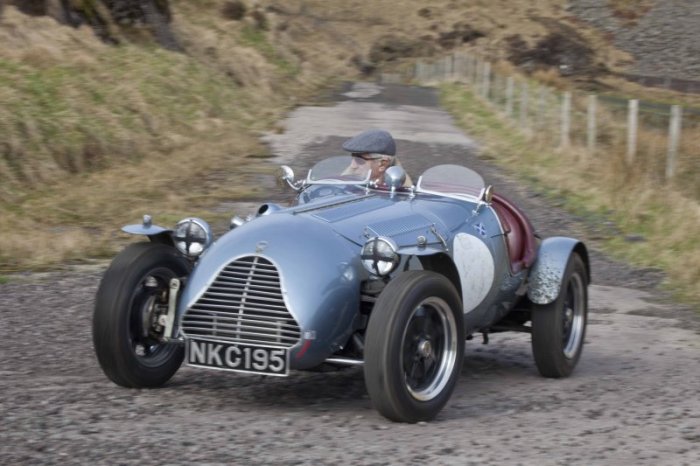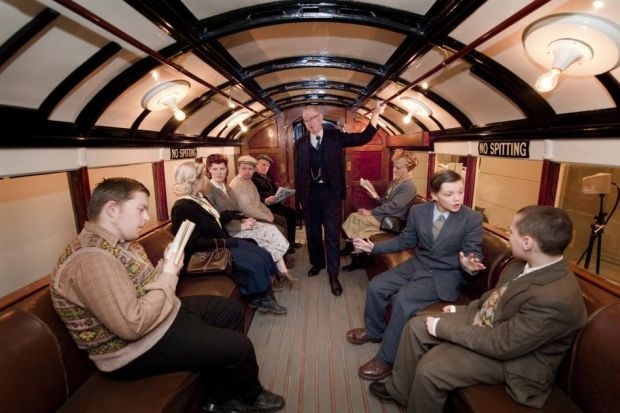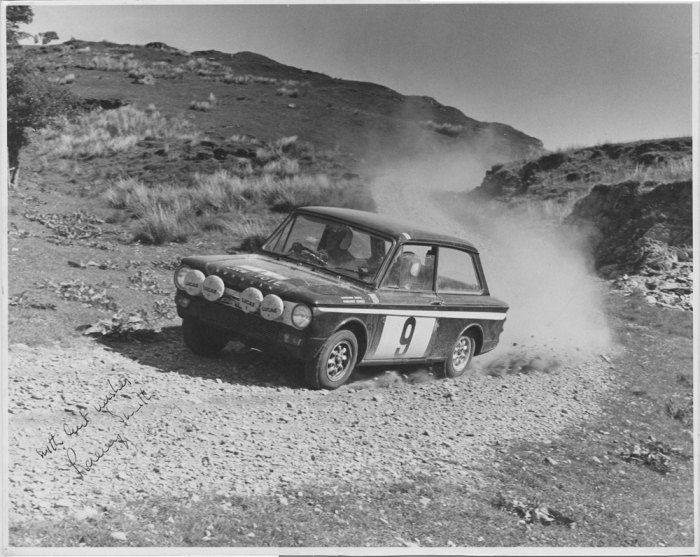Archive for the ‘Curators’ Category
Two articles on Glasgow’s Riverside Museum
It’s great to see Glasgow’s Riverside Museum garnering attention from media all over the world.
Here’s an article on the project in Italian design magazine Abitare. And here’s another article, from a very different perspective, in the Journal of Victorian Culture Online.
Riverside Museum re-creates legendary hillclimb race on Scotland’s most famous road
The legendary hillclimbs up the Rest and Be Thankful road have been re-created for a dramatic display at the new Riverside Museum in Glasgow.
Seven classic cars took part in the re-enactment, which will be used in a display that tells the story of the notorious races up Scotland’s most famous – and most demanding – stretch of road.
The old Rest and Be Thankful road winds its way up from the floor of Glen Croe to the pass west of Ben Arthur – aka the Cobbler. Ascending it was an exhausting effort for the early automobiles, horses and drovers alike, hence its name.
But the Rest’s legendary status as a racing venue rose during the 1950s and 1960s when fearless racing drivers tested their mettle on the steep, hairpin-riddled road. Racers such as Jackie Stewart and “speed king” Basil Davenport helped seal the road’s position in Scottish motor sport’s hall of fame. The current road, the A83, opened in 1941, and follows the edge of Glen Croe, way above the old road.
As well as the film, the display at Riverside will see classic cars positioned on a rising “road” that follows the curve of the Zaha Hadid-designed museum. The display itself was designed by Event Communications.
Drivers from classic car club Friends of the Rest and Be Thankful took part in the re-enactment, which was filmed by Glasgow-based software firm 55 Degrees. Camera and sound crews positioned in key locations captured the cars as they came roaring up the glen. The cars included a 1924 Bugatti Type T, a Daimler Dart, an Austin Healey 3000, an MG MGA, a 1910 Ford Model T, a 1930 MG M-Type Midget Boat Tail Speedster, and a Cooper MG once driven by Stirling Moss.
Accompanying the racing footage will be in-car commentary, and interviews with former drivers and spectators from the 1950s and 1960s races, when hundreds of people perched amid the heathered slopes of Glen Croe to watch the races. For the en-enactment, curious passers-by and nearby residents lined the route.
Councillor Gordon Matheson, Leader of Glasgow City Council and Trustee of the Riverside Museum Appeal, said: “It’s wonderful that the Rest and Be Thankful and its historic hillclimbs are being immortalised in the new Riverside Museum. They’re an important part of Scotland’s motoring heritage, and I’m extremely grateful to the Friends of the Rest and Be Thankful and the communities of Arrochar, Ardlui, Tarbet and Succoth for their help in making this exciting film.”
Andrew Davidson, owner of Glencroe Farm and the old road, said, “I’m delighted that the Rest and Be Thankful hill climb was used to film footage on the old road for the new Riverside Museum display. It was a joy to watch fellow members of the Friends of the Rest group re-creating the road’s glory days in their classic cars.”
Gavin McLellan, Director of the Riverside Museum Appeal, said: “The dramatic re-enactment of the Rest and be Thankful hillclimb is another example of the public support for the new Riverside Museum, with so many people giving up their time to support this film. With opening day just over two months away, there’s still time for everyone to have a place inside this new museum. A donation to the Riverside Museum Appeal will ensure that your name or that of someone you love will be a permanent presence inside the museum, just like those who starred in this exciting re-creation. We’ve raised £4.2million and have less than £1million to go – a terrific achievement. To donate online, please visit www.riversideappeal.org or text the word ‘Riverside’ and your name to 70700 to give £5.”
Riverside Museum and The Tall Ship Glenlee opens to the public on 21st June at 10am.
Museum drama brings Glasgow’s wartime subway to life
More than 50 volunteers and professional actors donned 1940s costumes to star in an innovative short film that will be broadcast on an antique subway train inside the new Riverside Museum.
The 28-minute period drama is set on the 1930s subway car, a well-known feature of the old Museum of Transport at Kelvin Hall, and part of Glasgow Museums’ collection. Visitors to Riverside Museum will be able to board the subway and watch the performance, which will be back-projected onto the end of the train.
During the drama, the 17 actors and 36 extras board and alight at various “stations” on the route. One of these stations included Merkland Street Station, which was bombed in 1940 and re-opened the following year. The drama is set a few weeks after the station re-opened with travellers still anxious about the risks of attack. Despite the fears, Glasgow’s subway was regarded as a safe way to travel during the Second World War, and by 1945 more than 34 million people were travelling on it.
Joseph Briffa, Head of Film and Video at 55degrees, the multi-media production company that made the film, said the production was one of the most ambitious and challenging shoots they’d ever worked on. He said, “We had some 60 actors entering and leaving the subway carriage at very specific timings based on a real-time circuit of the subway in 1941, all in single 30-minute long takes. If there was the slightest mistake we had to re-set and return to the beginning. The technical challenge of this was extreme to say the least, and the level of concentration by everyone on set to make this happen was incredible.”
As well as the challenges of filming, production staff also had to ensure that the cast of 17 actors and 36 extras all boarded and left the train at exactly the right moment in the script. While aboard, the “travellers” had to sway as if they were standing on a moving train.
Kirsty Devine, Senior Curator at Riverside Museum, added “It was important we got the look perfect. We had to make sure the costumes, make-up, hairstyle and dialogue were all authentic. It was a fun and extraordinary couple of days. Everyone was fantastic, and it was lovely to see such enthusiasm for the new museum. By the time of the final shoot, however, wartime fatigue was definitely starting to show!”
Gavin McLellan, Director of the Riverside Museum Appeal, said “This filming is another example of the public support for the new Riverside Museum, with so many people giving up their whole weekend to feature in this film. There’s still time for members of the public to become part of the new museum. A donation to the Riverside Museum Appeal will ensure that your name or that of someone you love will be a permanent presence inside the museum, just like those who starred in this innovative wartime drama. And despite the difficult financial circumstances, we’ve raised about £4million and have £1million to go – a terrific achievement.”
To donate online, please visit www.riversideappeal.org or text the word ‘Riverside’ and your name to 70700 to give £5.
Glasgow’s original Subway opens for business

Here, what is thought to be the Directors and some staff of the Glasgow and District Subway pose for an opening day photo. It had taken over 5 ½ years to finish two tunnels and 15 stations.
On December 14th 1896, the Glasgow and District Subway began operation. Thousands of Glaswegians flocked for a chance to ride for only 1d (1 old pence). Only London and Budapest had built subway systems, so it must have been entirely new experience to almost all those riding it on opening day. Today, many of us take the subway for granted, but to Glaswegians of 1896, it truly was a modern marvel!
Glasgow Museums has a large collection relating to the subway, and indeed featured a recreated subway station at the old Museum of Transport in the Kelvinhall. The new Riverside Museum will once again feature displays on the Subway, exploring its history, how it once operated by being pulled by a 6.5 mile long cable, and the people one might find while taking a trip around the city.
Tall Ship launches Titanic appeal
 Do you have a connection to the Titanic? Perhaps you or someone you know had a relative on board the tragic liner. Perhaps you’ve a connection to the ship’s construction, or to James Cameron’s famous film. If so, our friends at the Tall Ship Glenlee would love to hear from you.
Do you have a connection to the Titanic? Perhaps you or someone you know had a relative on board the tragic liner. Perhaps you’ve a connection to the ship’s construction, or to James Cameron’s famous film. If so, our friends at the Tall Ship Glenlee would love to hear from you.
The Clyde Maritime Trust, owner of the Glenlee, is having a Titanic Reunion Lunch at 12noon on Monday 24th January, and would love anyone with a personal connection to the Titanic to contact them.
The reunion lunch is part of an events programme to celebrate The Tall Ship’s current exhibition Titanic: Honour & Glory. The exhibition is the largest private collection of Titanic objects in Scotland and features a diverse range of stunning and very rare pieces from the Titanic and her sister ships, plus magnificent props and costumes from James Cameron’s 1997 movie Titanic, including a beautiful necklace worn by Kate Winslet in the film.
The Titanic exhibition is on at The Tall Ship until 27th February, open daily 10am-4pm, Admission £3 (concs £2).
The reunion lunch on 24th January will be followed at 2pm with a special talk by Titanic exhibition manager Sean Szmalc, who will unravel the gripping story of Titanic and her sister ships. The talk is free for those attending the reunion and £5 admission otherwise. To attend the reunion, please contact David Cowan at The Tall Ship with your Titanic story on 0141 222 2513, or email him.
A glimpse of Glasgow nearly 100 years ago
Look closely. What can you see? What can one picture tell you about the history of Glasgow?
Just one photo can say so much about the history of a city and its people. This photo was taken in 1914 by Glasgow Corporation as part of a Water and Tramways Bill. It was meant to show just how much traffic was on the streets. But, looking at the picture, you can tell so much more about Glasgow at the time. Horse carts making deliveries, men pushing a barrow, a boy selling that day’s newspaper.
The Riverside Museum curatorial team have pored over thousands of photographs during their research for the new museum. Sometimes you find things you never expected to see! You might find out how much a trip to England from Thomas Cook & Sons cost in 1914. Or what a shop was selling at on the eve of World War I.
This is one of hundreds of photographs that will feature in the new museum. You will be able to look for yourself and find out just what YOU can see when we open next spring.
Remembering the women who kept Glasgow moving during World War I

A group of female Glasgow Tramways employees ready for service. During World War I the Tramways needed all the help it could get to keep the city moving...even a miniature Charlie Chaplin seemed ready to help.
It is 1915. Britain is at war with Germany. Thousands of men have volunteered for the army, leaving their jobs to fight for King and Country. Without them working their daily jobs, the nation would have come to a stand still. Britain needed help. Britain needed its women.
Glasgow faced a shortage of men to operate the city’s vast tram fleet. So, a controversial experiment took place. The Glasgow Tramways decided to take on women as drivers and conductresses. Never before had females been allowed to work as a motorman on a tram. Great opposition came from the press and the public.
In December of 1915 The People’s Journal reported that the general public “decided that the new departure would only end in failure. Women were constitutionally unfit for such an onerous purpose and the majority of the tramway employees were of the same way of thinking.”
The opposition was strong, but the experiment proved a success. Women were allowed to be motorman and conductresses, at least until the men came home!
Curator Aileen Strachan has been investigating this radical experiment from Glasgow’s rich history. The story of these pioneers and how transport impacts lives will be one of many featured in the new Riverside Museum.
Drama school for a Glasgow industrial relic

The North British Locomotive Company's Flemington Street office building. A versatile building, it was turned into a hospital during World War I, and served as the HQ for the company’s badminton club.
The administration building of the North British Locomotive Company featured in last night’s episode of Lip Service, BBC3’s Glasgow-based drama. Two of the characters visited what was said to have been their old secondary school.
In fact it was the former offices of the largest locomotive builder in Europe! The building, known as Flemington Street, opened in 1909 and was the hub where orders from around the world poured in and plans for thousands of locomotives were drawn up.
The offices were adjacent to the Hyde Park Works, one of the company’s three Glasgow works. It was from this factory that our No. 9 tank engine rolled onto the rails in 1917.
Although not a secondary school as portrayed in the show, the building was home to the North Glasgow College after the locomotive works closed in 1962. The college recently opened their new building, just across the street on the former site of Hyde Park Works.
Rosemary Smith, the Hillman Imp and the Monte Carlo Rally
Great news. Next year’s Monte Carlo Rally will kick off from Glasgow’s Blythswood Square as part of the race’s centenary celebrations. Glasgow might seem an unlikely starting point for one of the world’s most glamorous rallies, but the city was among the original line-up for the first Monte Carlo Rally in 1911. The tradition was revived in the 1960s and 70s, when Glasgow was again one of the endurance race’s starting points.
One of the most renowned Monte Carlo Rally drivers is Rosemary Smith, who triumphed in numerous races in her Imp Sunbeam, the racing variant of the Linwood-produced Hillman Imp. In 1966, Smith won the ladies’ Monte but was later disqualified in a controversial decision that many people claimed was unfair. Glasgow Museums has in its collection several photos of Smith racing her Imp as well as photos of Provost Jean Roberts starting the Monte Carlo race from the RAC Club on Blythswood Square in 1961. Below’s a dramatic shot of Smith and her navigator Margaret Downey. We think it’s from 1971.
Glasgow Museums’ collection is also fortunate to have the very first Imp to roll off the Rootes factory production line. You’ll be able to see Imp 1 in its new home at Riverside Museum after it opens in spring next year.
More Teamwork Caught on Camera
A few weeks ago we showed you some of the people involved in the preparations for the new Riverside Museum. This slideshow continues this series with images of yet more of the team.



